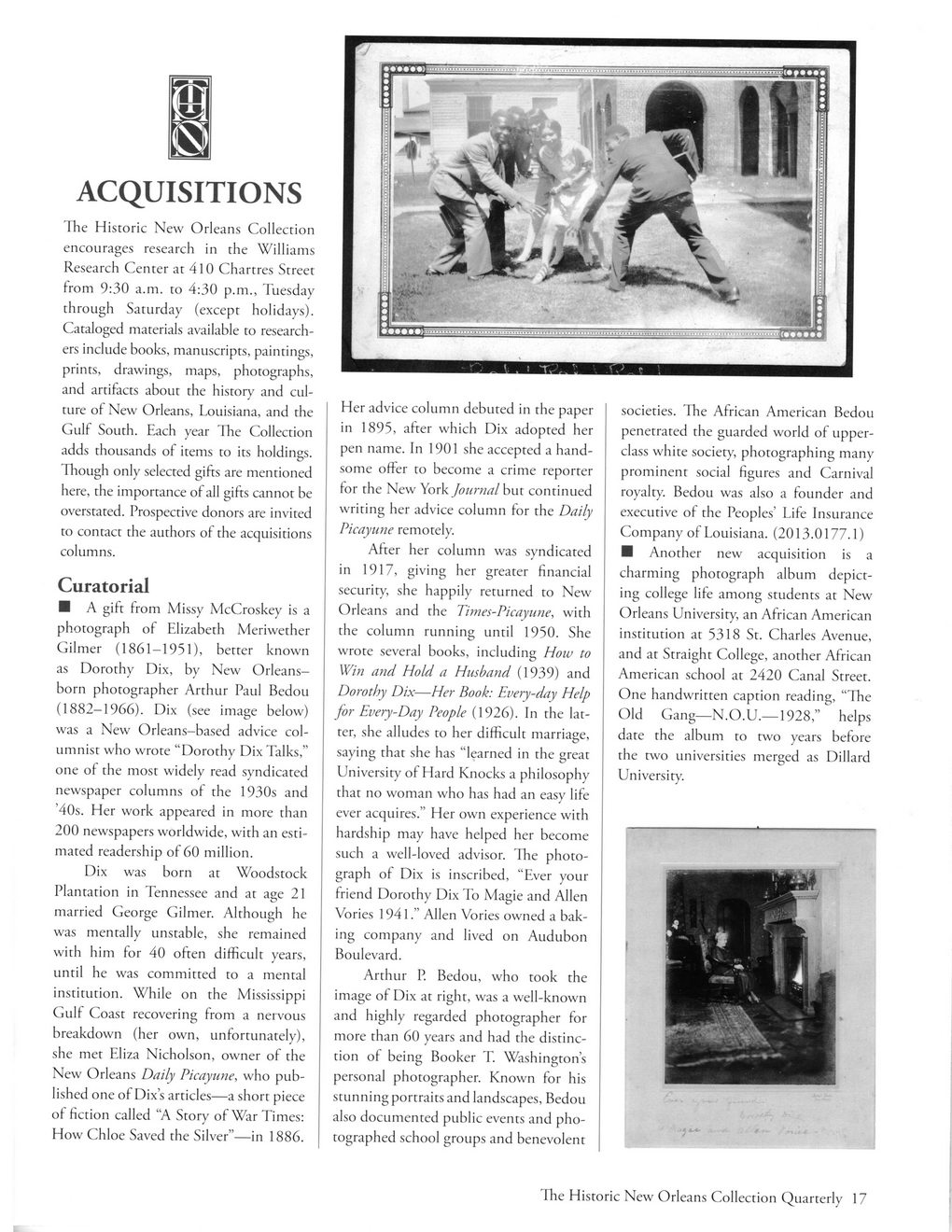This text was obtained via automated optical character recognition.
It has not been edited and may therefore contain several errors.
ACQUISITIONS The Historic New Orleans Collection encourages research in the Williams Research Center at 410 Chartres Street from 9:30 a.m. to 4:30 p.m., Tuesday through Saturday (except holidays). Cataloged materials available to researchers include books, manuscripts, paintings, prints, drawings, maps, photographs, and artifacts about the history and culture of New Orleans, Louisiana, and the Gulf South. Each year The Collection adds thousands of items to its holdings. Though only selected gifts are mentioned here, the importance of all gifts cannot be overstated. Prospective donors are invited to contact the authors of the acquisitions columns. Curatorial ■ A gift from Missy McCroskey is a photograph of Elizabeth Meriwether Gilmer (1861-1951), better known as Dorothy Dix, by New Orleans-born photographer Arthur Paul Bedou (1882—1966). Dix (see image below) was a New Orleans-based advice columnist who wrote “Dorothy Dix Talks,” one of the most widely read syndicated newspaper columns of the 1930s and ’40s. Her work appeared in more than 200 newspapers worldwide, with an estimated readership of 60 million. Dix was born at Woodstock Plantation in Tennessee and at age 21 married George Gilmer. Although he was mentally unstable, she remained with him for 40 often difficult years, until he was committed to a mental institution. While on the Mississippi Gulf Coast recovering from a nervous breakdown (her own, unfortunately), she met Eliza Nicholson, owner of the New Orleans Daily Picayune, who published one of Dix’s articles—a short piece of fiction called “A Story of War Times: How Chloe Saved the Silver”—in 1886. Her advice column debuted in the paper in 1895, after which Dix adopted her pen name. In 1901 she accepted a handsome offer to become a crime reporter for the New York Journal but continued writing her advice column for the Daily Picayune remotely. After her column was syndicated in 1917, giving her greater financial security, she happily returned to New Orleans and the Times-Picayune, with the column running until 1950. She wrote several books, including How to Win and Hold a Husband (1939) and Dorothy Dix—Her Book: Every-day Help for Every-Day People (1926). In the latter, she alludes to her difficult marriage, saying that she has “learned in the great University of Hard Knocks a philosophy that no woman who has had an easy life ever acquires.” Her own experience with hardship may have helped her become such a well-loved advisor. The photograph of Dix is inscribed, “Ever your friend Dorothy Dix To Magie and Allen Vories 1941.” Allen Vories owned a baking company and lived on Audubon Boulevard. Arthur P. Bedou, who took the image of Dix at right, was a well-known and highly regarded photographer for more than 60 years and had the distinction of being Booker T. Washington’s personal photographer. Known for his stunning portraits and landscapes, Bedou also documented public events and photographed school groups and benevolent societies. The African American Bedou penetrated the guarded world of upper-class white society, photographing many prominent social figures and Carnival royalty. Bedou was also a founder and executive of the Peoples’ Life Insurance Company of Louisiana. (2013.0177.1) I Another new acquisition is a charming photograph album depicting college life among students at New Orleans University, an African American institution at 5318 St. Charles Avenue, and at Straight College, another African American school at 2420 Canal Street. One handwritten caption reading, “The Old Gang—N.O.U.—1928,” helps date the album to two years before the two universities merged as Dillard University. The Historic New Orleans Collection Quarterly 17

New Orleans Quarterly 2013 Fall (17)